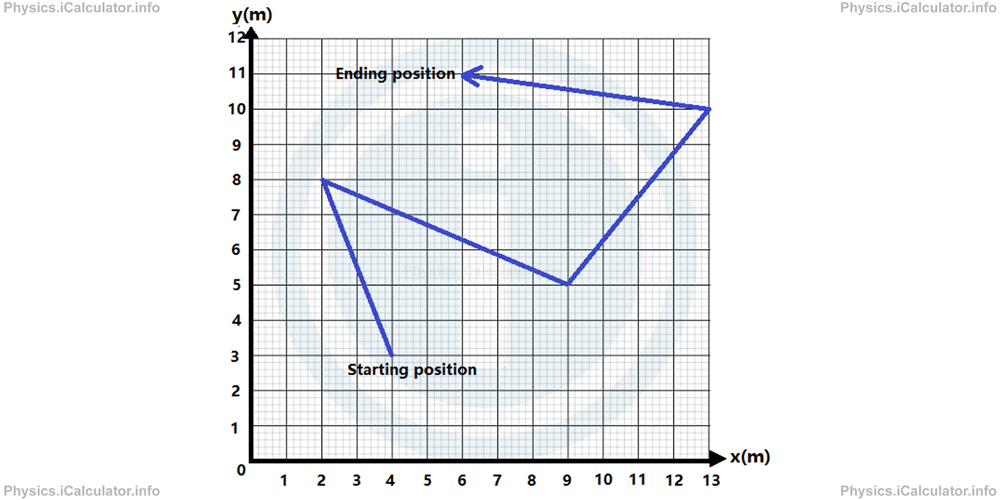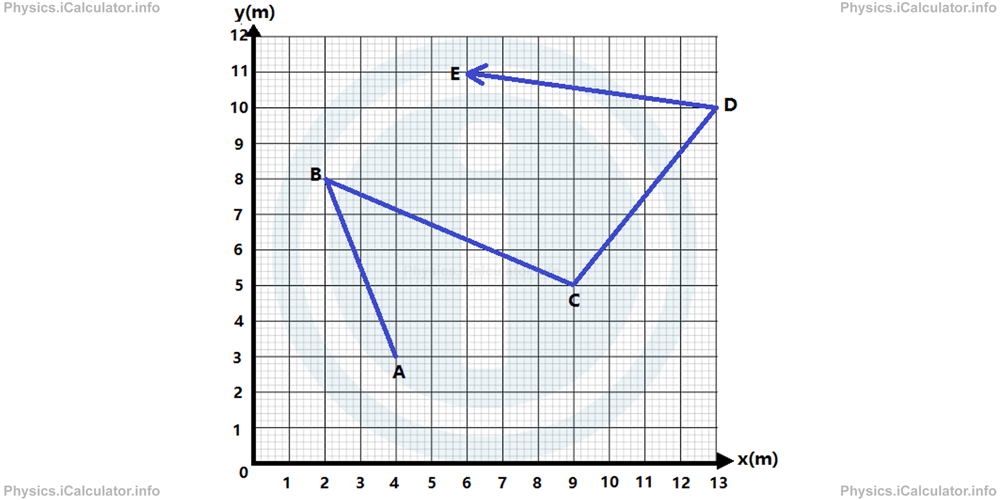Menu
Physics Lesson 3.6.1 - Speed in Two Dimensions
Please provide a rating, it takes seconds and helps us to keep this resource free for all to use
Welcome to our Physics lesson on Speed in Two Dimensions, this is the first lesson of our suite of physics lessons covering the topic of Speed and Velocity in 2 and 3 Dimensions, you can find links to the other lessons within this tutorial and access additional physics learning resources below this lesson.
Speed in Two Dimensions
Let's start with the average speed first. Thus, basically, the calculation of the average speed in two dimensions consists on the following steps:
- Splitting the distance in small regular segments (exactly as we did when we were discussing about the calculation of distance in two dimensions).
- Finding the horizontal and vertical components for each segment. The values are all positive regardless the direction as we are dealing with distance, not displacement.
- Using the Pythagorean Theorem for calculating the distance in each segment (it represents the hypotenuse of each small right triangle formed).
- Finding the sum of all hypotenuses obtained at (3). This gives the total distance travelled.
- Dividing the distance found at (4) to the total time taken during the entire process.
The result obtained at (5) represents the average speed of a moving object in two dimensions.
Example 1
Calculate the average speed of an object is it moves for 53 s according the path shown in the figure below.

Solution 1
We will use the procedure described above to find the average speed.
For simplicity, we divide the path into 4 segments and we appoint letters to each bordering point. They are AB, BC, CD and DE. Look at the figure below:

Let's calculate the components now. Thus, for the horizontal part of motion, we have
BCx = |xC - xB| = |9m - 2m| = |7m| = 7m
CDx = |xD - xC| = |13m - 9m| = |4m| = 4m
DEx = |xE - xD| = |6m - 13m| = |-7m| = 7m
The same procedure is used for the vertical direction as well:
BCy = |yC - yB| = |5m - 8m| = |-3m| = 3m
CDy = |yD - yC| = |10m - 5m| = |5m| = 5m
DEy = |yE - yD| = |11m - 10m| = |1m| = 1m
Now, we will calculate the distance travelled in each segment:
BC = √BC2x+BD2y = √(7m)2+(3m)2 = √49m〗2+9m2 = √58m2 = 7.6m
CD = √CD2x+CD2y = √(4m)2+(5m)2 = √16m2+25m2 = √41m2 = 6.4m
DE = √DE2x+DE2y = √(7m)2+(1m)2 = √49m2+1m2 = √50m2 = 7.1m
Now, let's calculate the total distance. We have:
= 5.4m + 7.6m + 6.4m + 7.1m
= 26.5m
The average speed therefore is
For instantaneous speed, we use again the same procedure as in the one-dimensional motion, i.e. after calculating the distance in a small interval around the required point (using the Pythagorean Theorem for the two given directions), we divide it by the given time interval. The result obtained gives the instantaneous speed in two dimensions.
You have reach the end of Physics lesson 3.6.1 Speed in Two Dimensions. There are 3 lessons in this physics tutorial covering Speed and Velocity in 2 and 3 Dimensions, you can access all the lessons from this tutorial below.
More Speed and Velocity in 2 and 3 Dimensions Lessons and Learning Resources
Whats next?
Enjoy the "Speed in Two Dimensions" physics lesson? People who liked the "Speed and Velocity in 2 and 3 Dimensions lesson found the following resources useful:
- Speed Feedback. Helps other - Leave a rating for this speed (see below)
- Kinematics Physics tutorial: Speed and Velocity in 2 and 3 Dimensions. Read the Speed and Velocity in 2 and 3 Dimensions physics tutorial and build your physics knowledge of Kinematics
- Kinematics Revision Notes: Speed and Velocity in 2 and 3 Dimensions. Print the notes so you can revise the key points covered in the physics tutorial for Speed and Velocity in 2 and 3 Dimensions
- Kinematics Practice Questions: Speed and Velocity in 2 and 3 Dimensions. Test and improve your knowledge of Speed and Velocity in 2 and 3 Dimensions with example questins and answers
- Check your calculations for Kinematics questions with our excellent Kinematics calculators which contain full equations and calculations clearly displayed line by line. See the Kinematics Calculators by iCalculator™ below.
- Continuing learning kinematics - read our next physics tutorial: The Meaning of Acceleration. Constant and Non-Constant Acceleration. Gravitational Acceleration
Help others Learning Physics just like you
Please provide a rating, it takes seconds and helps us to keep this resource free for all to use
We hope you found this Physics lesson "Speed and Velocity in 2 and 3 Dimensions" useful. If you did it would be great if you could spare the time to rate this physics lesson (simply click on the number of stars that match your assessment of this physics learning aide) and/or share on social media, this helps us identify popular tutorials and calculators and expand our free learning resources to support our users around the world have free access to expand their knowledge of physics and other disciplines.